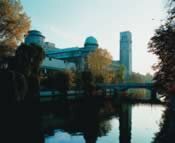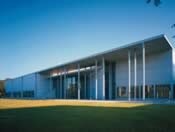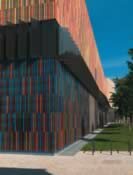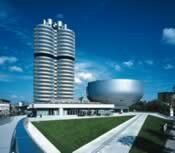Inflight Magazine of Brussels Airlines
Welcome to the Inflight Magazine of Brussels Airlines
The business of culture
Guy Dittrich reports on the government initiatives and private foundations that are responsible for ensuring Munich’s standing among Europe’s cultural elite
 It isn’t often that a recession brings good news. But amid reports that the German economy is suffering its worst crisis since the Second World War, Munich has discovered that every cloud has a silver lining. Within the €82bn stimulus package of Chancellor Angela Merkel is a portion allocated to maintaining the country’s cultural legacy, through funds to kick-start infrastructure projects. The largest single beneficiary, with €29m, is the country’s most popular museum, Deutsches Museum, on the banks of the Isar River that flows through the Bavarian capital.
It isn’t often that a recession brings good news. But amid reports that the German economy is suffering its worst crisis since the Second World War, Munich has discovered that every cloud has a silver lining. Within the €82bn stimulus package of Chancellor Angela Merkel is a portion allocated to maintaining the country’s cultural legacy, through funds to kick-start infrastructure projects. The largest single beneficiary, with €29m, is the country’s most popular museum, Deutsches Museum, on the banks of the Isar River that flows through the Bavarian capital.
“To put the value of culture into perspective, consider that more people go to museums in Bavaria each year than go to watch Bundesliga soccer games,” says Wolfgang Heckl, director general of Deutsches Museum, which welcomes more than 1.4 million visitors each year. According to the German cultural council, Deutscher Kulturrat, the not inconsiderable amount of €8.1bn was spent on culture in 2007, the latest year for which figures are available.
Within this national picture, Munich stands as the cultural heartbeat of southern Germany. With 42 museums and collections, more than 70 galleries and 58 large and small theatres, the southern state capital is more than a match for Berlin’s Museumsinsel or Museumsufer on Frankfurt’s River Main. Among this plethora of Munich institutions, Deutsches Museum focuses on natural science and technology. It is home to exhibits of several world firsts, among them the first car, X-ray and civil airliner. Its decaying edifice is much in need of a spruce-up and the €29m will be used in part to install new windows and to renovate the façade, making the museum more energy efficient.
 Clearly the museum’s status, with one of the most important collections of its kind in the world, will be enhanced by this facelift, but the impact on the wider economy of such spending is also significant. Furthermore, as a major tourist attraction – more than one-third of visitors are from outside Germany – the influence of Deutsches Museum on the revenues of the city from overnight stays and related expenditure is not to be underestimated, and neither is the direct, full-time employment of well over 400 people.
Clearly the museum’s status, with one of the most important collections of its kind in the world, will be enhanced by this facelift, but the impact on the wider economy of such spending is also significant. Furthermore, as a major tourist attraction – more than one-third of visitors are from outside Germany – the influence of Deutsches Museum on the revenues of the city from overnight stays and related expenditure is not to be underestimated, and neither is the direct, full-time employment of well over 400 people.
Deutsches Museum has also had to look to other sources of funding to secure and extend its future. In an agreement with the local and federal governments, major DAX-quoted companies – including Siemens AG, brake manufacturer Knorr-Bremse AG, industrial gas producer Linde AG, truck maker MAN AG, the world’s largest supplier of car components, Robert Bosch GmbH, and steel producer ThyssenKrupp AG, have pledged almost €40m. Government bodies now have to keep their side of the bargain and commit the remaining 90% that will allow for the total renovation of the museum.
Similar sponsorship comes from Amgen, an American biotechnology company that has put €750,000 into a centre of new technologies concentrating on genetics and nanotechnology, which is due to open in late 2009. Three research institutes – Fraunhofer-Gesellschaft, Helmholtz-Gemeinschaft and Max-Planck-Gesellschaft – have also supported the venture with €100,000 each.
“These sponsors, together with the University of Munich, will be able to display their latest research results here on subjects as wide ranging and topical as stem-cell therapy and gene technology in consumer products,” enthuses Heckl. “An entire research landscape is coming together.”
 On the other hand, some of Munich’s other museums are doing very well on their own, thank you – in particular Museum Brandhorst, which opened in May and is home to part of the 700-item Brandhorst Foundation. Udo Brandhorst, the heir of household goods giant Henkel, and his wife Annette, who died in 1999, established the foundation that includes more than 100 works by Andy Warhol, a near-complete archive of original illustrated books by Pablo Picasso and the most significant collection of Cy Twombly works in Europe. “Revenues [interest] from the €120m capital of the foundation are approximately €2m. This is more than the rest of Bavaria’s museums have to buy works of art,” explains Professor Klaus Schrenk, director general of the Bayerische Staatsgemäldesammlungen (Bavarian State Picture Collection), of the museum’s enviable position.
On the other hand, some of Munich’s other museums are doing very well on their own, thank you – in particular Museum Brandhorst, which opened in May and is home to part of the 700-item Brandhorst Foundation. Udo Brandhorst, the heir of household goods giant Henkel, and his wife Annette, who died in 1999, established the foundation that includes more than 100 works by Andy Warhol, a near-complete archive of original illustrated books by Pablo Picasso and the most significant collection of Cy Twombly works in Europe. “Revenues [interest] from the €120m capital of the foundation are approximately €2m. This is more than the rest of Bavaria’s museums have to buy works of art,” explains Professor Klaus Schrenk, director general of the Bayerische Staatsgemäldesammlungen (Bavarian State Picture Collection), of the museum’s enviable position.
Museum Brandhorst cost €48m and is housed in a stunning structure designed by Berlin-based architects Sauerbruch Hutton. The narrow construction is covered with a sleeve of 36,000 vertical ceramic rods in a random arrangement of 23 colours that gives a very different impression of the building from various angles.
The museum is part of the city’s Kunstareal (‘Arts Area’) and is a neighbour to the acclaimed concrete and glass structure of the Pinakothek der Moderne, which opened in 2002 and houses fascinating collections of modern and contemporary art, as well as industrial design.
Kunstareal is completed by two further museums – Alte Pinakothek, which presents major works by Leonardo da Vinci, Rembrandt and Peter Paul Rubens – and Neue Pinakothek, which includes works by French impressionists, as well as art-nouveau collections. Together, they form a major tourist attraction.
 Another recent addition to Munich’s vibrant cultural scene is the Jüdisches Museum, which opened in 2007 alongside the city’s gold-topped Ohel Jakob synagogue. Last year, the bowl-like BMW Museum to the north of the city was given a new extension, within which visitors can take a ‘road’ through the luxury car company’s history, with thematic presentations delivering the story in far more than just a chronological way. Münchner Stadtmuseum, with its collections of drawings, photography and film illustrating the city’s contemporary history, has also recently had a refit. Meanwhile, Lenbachhaus, home to the works of Der Blaue Reiter group, which included Wassily Kandinsky, Franz Marc, Gabriele Münter and August Macke, has just begun a renovation and redesign by the world-renowned architects Foster + Partners.
Another recent addition to Munich’s vibrant cultural scene is the Jüdisches Museum, which opened in 2007 alongside the city’s gold-topped Ohel Jakob synagogue. Last year, the bowl-like BMW Museum to the north of the city was given a new extension, within which visitors can take a ‘road’ through the luxury car company’s history, with thematic presentations delivering the story in far more than just a chronological way. Münchner Stadtmuseum, with its collections of drawings, photography and film illustrating the city’s contemporary history, has also recently had a refit. Meanwhile, Lenbachhaus, home to the works of Der Blaue Reiter group, which included Wassily Kandinsky, Franz Marc, Gabriele Münter and August Macke, has just begun a renovation and redesign by the world-renowned architects Foster + Partners.
The business of culture is important to the economy of Munich and is a year-round rival to the three-week Oktoberfest for which the city is better known. And while Müncheners enjoy their beer, there’s no question the city of just over one million people punches way above its weight in terms of culture. Add these cultural attributes to the ‘must-haves’ of safety, cleanliness and efficiency the city has in spades, and it’s no wonder Munich is consistently ranked high in lists of the world’s most liveable cities.
FR Le business de la culture
Guy Dittrich nous dresse un tableau des initiatives du gouvernement et des fondations privées, destinées à renforcer la place de Munich au sein de l’élite culturelle
Il est rare qu’une récession apporte son lot de bonnes nouvelles. Toutefois, en Allemagne, dans le paquet d’incitants récemment conclu pour un montant de 82Md €, une part est allouée au maintien du patrimoine culturel. Le plus grand bénéficiaire est le Deutsches Museum de Munich à hauteur de 29m €.
Munich est le coeur culturel du sud de l’Allemagne. “Chaque année, plus de gens se rendent dans les musées en Bavière que dans les stades de foot de la Bundesliga,” explique Wolfgang Heckl, directeur général du Deutsches Museum. Avec 42 musées et collections, plus de 70 galeries et 58 grands et petits théâtres, cette scène représente plus qu’un challenge pour Berlin ou Francfort.
Le Deutsches Museum centré sur les sciences naturelles et les technologies, héberge les premières voitures du monde, le rayon X et un avion de ligne. La dotation de 29m € sera utilisée partiellement pour installer de nouvelles fenêtres et rénover la façade. Le musée a également recherché d’autres sources de financement. De grandes compagnies, comme Siemens ou Robert Bosch cotées au DAX, la bourse allemande, se sont engagées pour 40m €.
D’autres musées munichois s’en sortent plutôt bien aussi. Le Brandhorst Museum, par exemple, qui a ouvert ses portes en mai pour un coût de 48m €. Il abrite une partie des 700 œuvres d’art moderne et contemporain de la Fondation Brandhorst. “Les revenus [les intérêts] du capital de 120m € de la fondation représentent environ 2m €,” explique le Professeur Klaus Schrenk, directeur général des Collections publiques de la Bavière. “Cette somme représente plus que ce dont disposent les musées bavarois pour acheter des œuvres d’art.” Le musée vient enrichir le Kunstareal (le quartier des arts de Munich) qui comprend la Pinacothèque d’Art Moderne, l’ancienne et la nouvelle Pinacothèque.
D’autres musées viennent animer cette scène culturelle faste de Munich comme le Musée Juif et l’impressionnante extension du Musée BMW. Le Musée de la Ville de Munich a également bénéficié récemment d’une remise en état. Il apparaît clairement que cette ville d’un million d’habitants fait preuve d’une vitalité en termes de culture qui dépasse largement sa dimension.
NL Cultuur is big business
Guy Dittrich brengt verslag uit over de overheidsinitiatieven en privéstichtingen die de plaats van München bij de culturele elite verzekeren
Een recessie brengt zelden goed nieuws met zich mee. Maar in het Duitse stimuleringspakket van € 82 miljard wordt een deel uitgetrokken voor het onderhouden van het culturele erfgoed van Duitsland. Het Deutsches Museum in München krijgt met € 29 miljoen de grootste hap van de koek. München is het culturele hart van het zuiden van Duitsland. “Het aantal bezoekers van musea is op jaarbasis hoger dan het totale aantal mensen dat naar voetbalwedstrijden in de Bundesliga gaat kijken,” zegt Wolfgang Heckl, directeur-generaal van het Deutsches Museum. Berlijn telt 42 musea en verzamelingen, meer dan 70 galerijen en 58 kleine en grote theaters, waarmee het allesbehalve misstaat naast Berlijn en Frankfurt.
Het Deutsches Museum is vooral gefocust op wetenschap en technologie. Het herbergt de eerste auto, het eerste röntgenapparaat en het eerste passagiersvliegtuig ter wereld. De € 29 miljoen wordt gebruikt voor het plaatsen van nieuwe ramen en het renoveren van de gevel. Het museum verzamelt ook op andere manieren fondsen. Grote beursgenoteerde bedrijven zoals Siemens AG en Robert Bosch Gmbh doen een duit van bijna € 40 miljoen in het zakje.
Een aantal andere musea in München redden het wonderwel op eigen houtje. Een voorbeeld? Het Brandhorst Museum heeft € 48 miljoen gekost en opende zijn deuren in mei. Het stelt een deel van de collectie van de Brandhorst Foundation tentoon, die in totaal meer dan 700 werken rijk is. “De inkomsten [intresten] van het kapitaal van € 120 miljoen van de stichting bedragen zo’n € 2 miljoen,” zegt professor Klaus Schrenck, directeur-generaal van de Bavarian State Picture Collection. “Dat is meer dan alle andere musea van Bavaria, die kunstwerken moeten aankopen.” Het museum draagt bij tot de Kunstareal van de stad, waartoe ook de Pinakothek der Moderne, de Alte Pinakothek en de Neue Pinakothek behoren. Andere recente nieuwkomers in de bruisende culturele scene van München zijn het Joods Museum en het reusachtige BMW Museum. Ook het Stadsmuseum van Münich werd onlangs opgeknapt.
Een ding is duidelijk: deze stad van een miljoen inwoners scheert cultureel hoge toppen.
Leave a Reply
